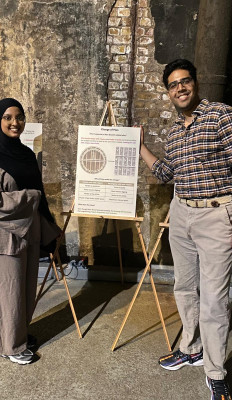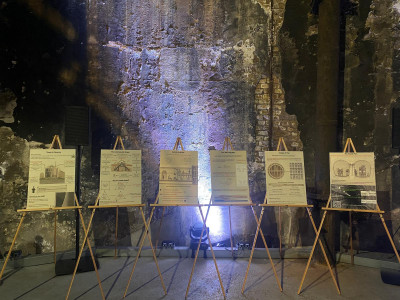News
Engineering students showcase public engagement work from Brunel Museum collaboration
6 August 2025


Three second-year undergraduate students Yash Vaghela, Malmi Mahagamage and Meherun Soud presented their designed public engagement exhibit outputs at showcase events organised on Wednesday 30th July and Sunday 3rd August in collaboration with The Brunel Museum, as part of their summer internship project titled 'From Classroom to Community: Engineering Meets History at The Brunel Museum' supervised by Dr Rehan Shah from Queen Mary School of Engineering and Materials Science and Dr Jack Hayes, Collections Access Coordinator for the Brunel Museum in London, funded by a grant awarded by the Queen Mary Centre for Public Engagement (CPE).
The Brunel Museum is an educational charity located in Rotherhithe in South London, dedicated to telling the story of the world’s first underwater tunnel built in 1825 and the lives of those who built and used it. It was built using revolutionary engineering techniques developed by Marc Brunel, the father of the more famous Isambard Kingdom Brunel. These techniques are still used today in civil engineering and tunnel construction projects worldwide.
The museum has a small, dedicated staff and a group of volunteers who engage the public, especially families and local communities, in STEM education and heritage. However, the museum’s team lacked the specific engineering expertise required to fully understand and communicate the complex and innovative engineering methods used in the Thames Tunnel project to its audiences.
The project, ‘Engineering Meets History’, aimed to address this gap through engaging with three current SEMS undergraduate students as part of a six-week summer internship programme from mid-June to end-July 2025, supervised by Dr Shah. After receiving dedicated engagement training and support, they collaborated with the museum’s community curator and collections coordinator to conduct research into the museum’s archive of historic drawings, prints, and watercolours, and those related to the Thames Tunnel at the Institute of Civil Engineers. With the help of their technical knowledge and experience, they reinterpreted these historic sources through an engineering lens to produce a series of design engagement resources that helped explain the engineering methods used in the tunnel’s construction in a way that was accessible both to the museum team and its audiences.
The internal (to museum staff and QMCPE representative) and external (to the wider public, including families and children) showcase events held at the end of the project allowed the students to take the lead in sharing their knowledge and expertise by presenting their created resources, which received positive feedback and reception.
The students also gained valuable research experience in archival study, developed their communication skills, and benefitted immensely from the opportunity to collaborate with a community partner to produce tangible, impactful resources. These experiences have not only enhanced their employability prospects, but also provided them with a unique insight into working in a heritage environment with professionals, producing materials that will be used by the public.
The findings from the project will be disseminated to the wider community via the CPE's evaluation report and Engagement Blog as well as through presentations at internal seminars and external education/public engagement-focused conferences.
| Contact: | Dr Rehan Shah |
| Email: | rehan.shah@qmul.ac.uk |
| People: | Rehan SHAH |
| Research Centre: | Research in Engineering and Materials Education |




